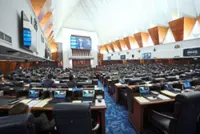Refurbishment needed: The iconic Bangunan Sultan Abdul Samad in Jalan Raja, Kuala Lumpur, is a popular spot for tourists and is often used as a backdrop for photos and selfies. — MUHAMAD SHAHRIL ROSLI/The Star
Conflicts over ownership, lack of accountability to blame for poor condition of historical buildings, say heritage buffs
IT IS high time Kuala Lumpur’s historic Jalan Raja area, home to several iconic buildings such as Bangunan Sultan Abdul Samad (BSAS), received recognition as a Unesco World Heritage Site, say stakeholders.
This initiative, championed by a diverse group including architects, history buffs, heritage aficionados and tourism specialists, aims to fortify protections for the capital city’s historical structures, some of which are in poor shape and suffering from dry rot.
ALSO READ: Unesco recognition for KL buildings unlikely to succeed, says don
They believe achieving Unesco status is crucial to prevent further deterioration of these sites.
They say it will ensure that key institutions like the National Heritage Department (JWN) and Kuala Lumpur City Hall (DBKL), take decisive action to preserve these cultural assets for future generations.
World Heritage Sites are designated by Unesco for having cultural, historical, scientific or other forms of significance.
Malaysian Institute of Architects (PAM) president Abu Zarim Abu Bakar said BSAS was ideally situated for this designation as it was right in the heart of the city, prominently visible from the MRT and LRT lines, and adjacent to Dataran Merdeka, another historical site.
“It possesses immense (Unesco) potential.
“However, the Unesco designation should encompass not only BSAS but also the entire precinct,” he added.
Among the buildings in the area of historical significance are the former Sanitary Board and Federated Malay States (FMS) Survey Department headquarters, the National Textile Museum, St Mary’s Cathedral, Royal Selangor Club, Panggung Bandaraya, old Chartered Bank building, the Industrial Court and the old Supreme Court building.
Veritas Design Group vice-president Lilian Tay, emphasised that the city should aspire to have its national treasures listed.
“We often underestimate our historical buildings. We should carefully select a few gems and compile a comprehensive dossier.
“It’s a daunting task, but crucial, particularly since once the area is protected, the recognition would compel authorities to ensure compliance with guidelines under the Heritage Act 2005, thereby safeguarding the buildings from future development,” added Tay, who is also an architect.
Their eagerness to advocate for the Unesco designation is understandable, given media reports about BSAS and many other heritage structures in the Jalan Raja and River of Life (RoL) areas being in various states of disrepair due to neglect.
The 127-year-old BSAS is a case in point. The building draws inspiration from Moorish archi tecture, and stands out amid its neighbouring structures.
It initially served as the Government Offices during the British administration era.
It was renamed in 1974, to honour Sultan Abdul Samad, the reigning monarch of Selangor when construction started in 1894. The building was completed three years later.
Over the years, the building, which has four blocks, had been home to several government departments, as well as part of the Supreme Court (now renamed Federal Court), Court of Appeal and High Court.
But the courts were relocated to the Palace of Justice in Putrajaya in 2003 following a fire.
Presently, the premises accommodate the offices of the National Heritage Department and the Tourist Information Centre in the city, but several of the blocks have been left empty and are rundown.
Until last year, the facade was maintained by DBKL but heritage experts say there has not been any maintenance done in the interior for a long time, resulting in disrepair and crumbling structures.
Still, BSAS is in slightly better shape than the former Sanitary Board and Federated Malay States (FMS) Survey Department headquarters.
Built in 1910, it lost one of its dome spires eight years ago and is still in limbo.
Other designated national heritage buildings, like the old Chartered Bank and Industrial Court buildings, were also deteriorating, said Tay.
She said the Unesco designation would also ensure better control over development in the area, highlighting the ongoing repairs at the National Textile Museum due to damage from a nearby construction site.
Changing hands
One reason for the poor state of heritage structures around Jalan Raja was due to issues of building ownership (involving numerous agencies and ministries) and accountability, said Abu Zarim.
For example, BSAS and the FMS building fall under the Tourism, Arts, and Culture Ministry (Motac), with DBKL previously maintaining the facade.
In an interview back in 2020, a DBKL spokesperson told StarMetro that the old Supreme Court building (along Sungai Gombak) and FMS were handed over to DBKL to manage and maintain due to their declining condition.
This came after the then Federal Territories Minister Khalid Abdul Samad wrote to the Federal Land Commissioner requesting custodianship of the buildings, stating that he would nominate DBKL to manage it.
Khalid said the buildings were decaying rapidly and required urgent maintenance, and that DBKL had the financial means to carry out preservation, restoration and conservation work.
However, a representative from DBKL recently confirmed that based on the latest Cabinet decision, the local authority was told to hand over the buildings to Khazanah Nasional Bhd.
These heritage buildings were not the only ones to have changed hands over the years due to issues with restoration plans and costs.
Colonial-era mansions Carcosa and Seri Negara located in Persiaran Tuanku Jaafar, have also changed hands a few times between the Natural Resources and Environment Ministry, Motac, and recently to Khazanah.
These mansions were also once under DBKL. Since June 1, 2019, both buildings have been closed indefinitely.
Stevan Thang, former co-chairman of the Heritage Conservation Committee of PAM, likened the situation to a football being passed between agencies, and expressed concern about further delays exacerbating restoration costs.
Restoring architectural treasures
The urgency for repairs is heightened by the plans and preparations for Visit Malaysia Year 2026.
Beyond typical festivities, history enthusiasts, heritage advocates, and tour specialists are eager to know the fate of Kuala Lumpur’s architectural treasures.
Senior tour guide Jane Rai doubts the timely restoration of BSAS, Carcosa and Seri Negara to their former glory, suggesting at best a cleanup and illumination of the buildings at night.
She also highlighted the need for upkeep of the decaying RoL sites and addressing challenges posed by vandals.
History buff Sabri Zain stressed the significance of heritage buildings to Kuala Lumpur’s tourism appeal, as they embody the city’s rich history and culture, offering an immersive experience unlike brochures or posters.
Sabri suggests revitalising these buildings rather than leaving them to decay, advocating for public access through permanent exhibitions and events celebrating their history, architecture and significant events.
“Whatever spaces there that are safely accessible should welcome the public again – whether in the form of permanent exhibitions celebrating their past glories, or regular events to highlight different aspects of its history like historic events such as Merdeka Day, or the Great Flood of 1926,” added Sabri.
“Events celebrating the architects who built these grand edifices – there is a treasure trove of historical facts about these buildings from which we can weave countless stories that will surprise and delight.’’
Meanwhile when tabling Budget 2023 last year, the government announced that Khazanah would spearhead the establishment of the National Heritage Fund to encourage private sector involvement in preserving Malaysia’s national heritage.
This public-private partnership initiative aims to restore historic buildings, including BSAS and Carcosa and Seri Negara, in collaboration with ThinkCity.
These preservation efforts are expected to revitalise Kuala Lumpur, fostering a sense of national pride and cultural unity among its diverse populace.
When contacted, Khazanah said it was unable to comment at this stage about plans for the buildings.
A similar question was put to Heritage Commissioner Mohamad Muda Bahadin, who confirmed that the buildings were under Khazanah, but declined to comment further.













